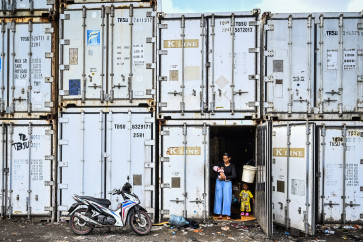Popular Reads
Top Results
Can't find what you're looking for?
View all search resultsPopular Reads
Top Results
Can't find what you're looking for?
View all search resultsRI needs to use more hybrid seeds to boost rice production
Indonesia needs to increase the use of hybrid seeds as part of its long-term national food strategy to meet a surge in rice demand, the Center for Indonesian Policy Studies (CIPS) has said
Change text size
Gift Premium Articles
to Anyone
I
ndonesia needs to increase the use of hybrid seeds as part of its long-term national food strategy to meet a surge in rice demand, the Center for Indonesian Policy Studies (CIPS) has said.
CIPS further recommended that the government give more support to hybrid rice research centers that are seeking to create new variants of hybrid seeds by, for example, offering them incentives.
By supporting these researchers, Indonesia can reduce its dependence on imported hybrid seeds, CIPS senior researcher Indra Krishnamurti said in a discussion in Jakarta on Tuesday.
“In the future, the sustainability of local research can maintain and expand the development of hybrid rice in Indonesia,” Indra said during his presentation of a report titled “Prospects and Challenges of Hybrid Rice in Indonesia”.
According to CIPS’ study, rice consumption in Indonesia will increase to 99.08 kilograms per capita by 2025 and 99.55 kg per capita by 2045 from 97.6 kg per capita in 2017. The figure is based on the assumption that the population will be between 311 million and 318.9 million in 2045 as compared to 264 million in 2019.
With hybrid seeds, farmers can harvest an average of 7 tons per hectare, higher than the more commonly planted inbred type that only yields around 5.15 tons per ha. The latter variant is also lower than the 6 ton per ha recommended by researchers in 2014 under the Agro Economic Research Forum to fulfill domestic needs.
Despite their benefits, hybrid seeds account for less than 1 percent of national rice plantation in 2014, CIPS found, and the figure has remained relatively stagnant in recent years.
“We always assume that our rice production continues to increase to a constant surplus, yet we still import [rice],” Indra said. “So, increased productivity [from hybrid seeds] could augment farmers’ earnings by increasing the harvest.”
The recommendation to promote the use of rice hybrid seeds was made amid the latest uproar over rice imports. State Logistics Agency (Bulog) chief Budi Waseso recently insisted that rice imports were no longer needed, as stocks were more than sufficient, and the agency’s warehouses could no longer accommodate any more rice.
In contrast to Bulog, the Trade Ministry issued a recommendation earlier this year to import 2 million tons of rice in 2018, despite Bulog’s claims of an oversupply, raising questions over a lack of coordination between the institutions to ensure a national rice supply.
Yet as a staple food, rice weighs heavily on household spending and on the consumer price index, forcing the government to take careful steps in ensuring stable prices when demand rises.
The government saw the potential of hybrid seeds around a decade ago by subsidizing them to increase their usage but retracted the decision after finding few benefits.
One reason is that compared to their counterparts, hybrid seeds are less resilient to pests and diseases while needing more manure and water to grow, making them unsustainable for less fertile conditions.
The variant is also relatively more expensive, peaking between Rp 110,000 (US$7.74 dollar) and Rp 135,000 per kg compared to the low-yield inbred seed that only costs around Rp 10,000 per kg.
But Indra argued that the government had only promoted a few variants to farmers with the aim of covering the most land with them, regardless of the seeds’ suitability for some parts of Indonesia. Poor seed performance from an unfitting environment ultimately made the seed unpopular among farmers after the subsidy was discarded, Indra said.
He also added that high productivity would offset initial investments for farmers, so he is calling on the government and agriculturalists to be aware of the seeds’ long-term benefits.
Indra recommended that the government partner with the private sector for researching, developing and commercializing hybrid rice variants. Pushing financial access to help farmers grow hybrid plants is equally critical in supporting their development, he said.
The Indonesian Chamber of Commerce and Industry’s (Kadin) food security committee vice head, H. Suharyo Husen, endorsed the researchers’ recommendation, adding that the private sector would be ready to join heads with the government if it rolled out a program for hybrid seeds.
The variant’s high price is also not an issue, Suharyo said, as extensive hybrid variant development resulting in larger supply would eventually push down prices. Indonesian Seed Association (Asbenindo) head Ricky Gunawan also said that using the variant could prevent extensive land expansion, as less land is needed to reap the adequate harvest.










